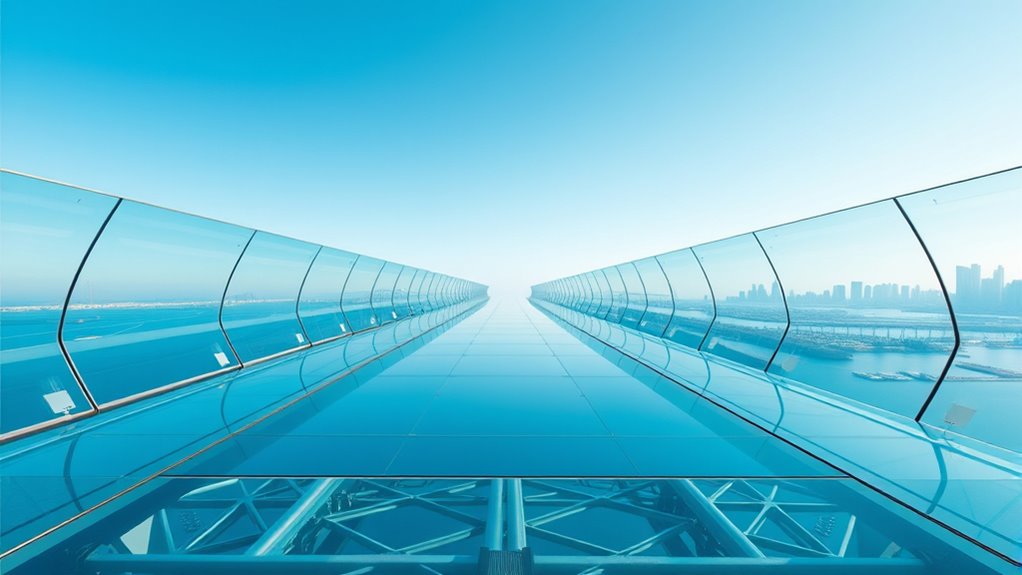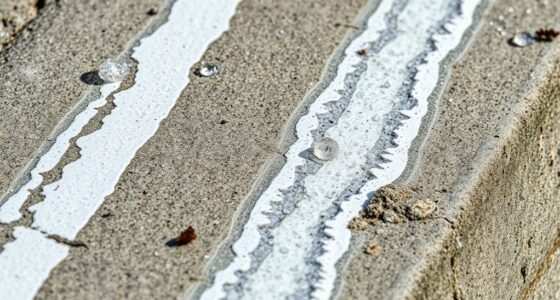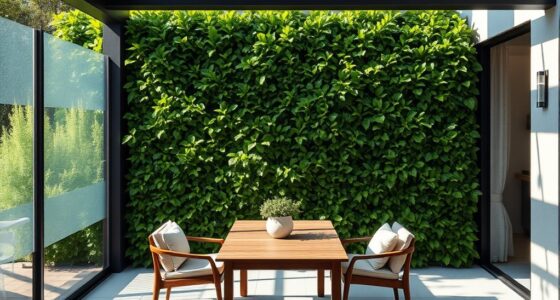To achieve vanishing edges, you need a clever structural engineering design that seamlessly integrates glass panels with hidden supports. Reinforced, laminated glass can safely handle water weight and external forces, while load distribution is carefully calculated to prevent stress points. Foundations and load-bearing supports are concealed to maintain the illusion of infinity, ensuring both safety and durability. For a detailed understanding of how these complex systems come together, keep exploring the key principles behind vanishing edge structures.
Key Takeaways
- Implement concealed supports like load-bearing beams or cantilevered structures to maintain seamless glass edges.
- Use reinforced, laminated glass designed to withstand water weight, wind, and temperature variations safely.
- Optimize load distribution across the glass facade with engineered framing systems to prevent stress points.
- Design foundations and load-bearing supports capable of handling combined water and environmental loads for stability.
- Conduct detailed structural calculations to ensure safety, durability, and preservation of the vanishing edge illusion.

Vanishing edges create stunning visual illusions that make pools and terraces appear to extend endlessly into the horizon. Achieving this effect requires careful structural engineering, particularly in how you handle glass facades and load distribution. As you design a vanishing edge, you need to contemplate the seamless integration of glass panels that form the boundary of the pool or terrace. These glass facades are not just aesthetic choices; they play a critical role in maintaining the illusion while ensuring safety and stability.
The glass must be structurally sound to withstand both the weight of the water and environmental forces like wind, rain, or temperature fluctuations. To do this, you’ll incorporate reinforced glass and precise framing systems that distribute loads evenly across the facade. Load distribution becomes essential here because the weight of the water, combined with external pressures, must be transferred safely to the supporting structure without creating stress points that could compromise the illusion or safety. You’ll often see load-bearing beams or cantilevered supports hidden beneath or behind the glass, cleverly concealed to preserve the visual flow.
Ensuring proper load distribution also involves detailed calculations and material choices. You need to select glass that not only looks sleek and transparent but can handle the expected loads without excessive thickness, which could detract from the visual effect. Structural engineers typically use high-strength, laminated glass, which offers both safety and durability. The framing system must be engineered to evenly spread the load across multiple points, preventing any single area from bearing too much weight. This approach maintains the integrity of the vanishing edge while allowing the visual seamlessness you desire.
Additionally, you must pay attention to the supporting infrastructure beneath the glass facade. The foundation and load-bearing walls should be designed to handle the combined weight of the water, glass, and environmental forces. Reinforced concrete or steel frameworks often underpin these systems, hidden from view but critical for stability. When executed properly, this foundation allows the glass to appear as if it’s floating, with no visible supports interrupting the illusion.
Furthermore, considering structural integrity early in the design process helps prevent potential failures and ensures longevity. In essence, the key to successful structural engineering for vanishing edges lies in balancing aesthetic vision with rigorous safety considerations. By carefully managing load distribution and selecting the right glass facades, you can create a stunning, seemingly endless horizon that captivates viewers while ensuring the structure’s safety and durability. It’s a delicate dance of engineering precision and design finesse—one that results in breathtaking, seamless vistas that feel almost surreal.
Frequently Asked Questions
What Are the Latest Innovations in Vanishing Edge Structural Engineering?
You should explore the latest innovations in vanishing edge structural engineering, like advanced waterproofing techniques that prevent leaks and enhance durability. Dynamic support systems are now being used to adapt to shifting loads and environmental conditions, ensuring stability and safety. These innovations allow for more seamless, aesthetically pleasing designs while maintaining structural integrity. Staying updated on these developments helps you create stunning, reliable vanishing edge features that stand the test of time.
How Do Climate Changes Impact Vanishing Edge Stability?
Climate impact can substantially threaten edge stability in vanishing edges by causing temperature fluctuations, increased rainfall, and stronger winds. These factors put stress on the structural components, potentially leading to erosion or weakening of support systems. You need to take into account these climate variables carefully in your design to guarantee the vanishing edge remains stable and safe under changing environmental conditions. Proper engineering solutions help mitigate these climate-related risks effectively.
Are There Eco-Friendly Materials Suitable for Vanishing Edge Constructions?
Yes, eco-friendly materials like recycled glass, bamboo, and sustainably sourced timber are suitable for vanishing edge constructions. You can also consider sustainable alternatives such as reclaimed steel or low-impact concrete mixes. These materials reduce environmental impact while maintaining durability and aesthetic appeal. By choosing eco-friendly options, you guarantee your vanishing edge project aligns with sustainability goals, helping protect the environment without compromising structural integrity or visual elegance.
How Is Safety Ensured During the Construction of Vanishing Edges?
You guarantee safety during vanishing edge construction by strictly following safety protocols and conducting thorough risk assessments. You should use proper barriers and harnesses to protect workers from falls and accidents. Regularly inspecting equipment and materials helps identify potential hazards early. Training your team on safety procedures and emergency responses is vital. By maintaining vigilance and adhering to safety standards, you minimize risks and create a secure environment throughout the project.
What Maintenance Practices Extend the Lifespan of Vanishing Edge Structures?
To extend your vanishing edge structure’s lifespan, you should regularly perform structural inspections to identify early signs of wear or damage. Incorporate waterproofing techniques like sealants and drainage systems to prevent water infiltration, which can weaken materials over time. Maintaining these practices guarantees your edge remains durable, safe, and visually stunning. Consistent upkeep helps catch issues early, saving you money and preserving the structure’s integrity for years to come.
Conclusion
So, here you are, marveling at those seemingly endless vanishing edges, unaware of the complex engineering holding them up. Ironically, what appears effortless is backed by meticulous calculations and innovative structures. It’s a delicate balance—one you might overlook amidst the beauty. Next time you gaze into that infinite horizon, remember: behind every seamless edge lies a web of unseen strength, proving that sometimes, the most impressive feats are the ones you never notice.










